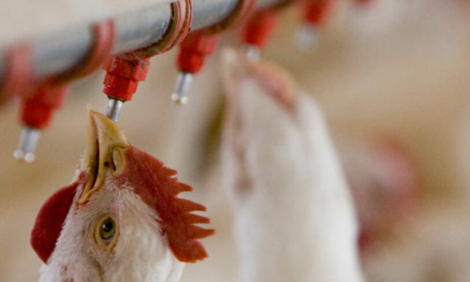Kazakhstan is the ninth largest nation in the world, about the size of Western Europe, with a population of 16.6 million. Kazakhstan's economy grew by 7.3 per cent in 2010 and by 7.1 per cent in the first half of 2011. In September 2002, Kazakhstan became the first country in the former Soviet Union to receive an investmentgrade credit rating from a major international credit rating agency.
The economy is dominated by the oil industry. Kazakhstan possesses enormous fossil fuel reserves and plentiful supplies of other minerals and metals. It also has a large agricultural sector; agriculture accounts for six per cent of GDP and employs 22 per cent of the labour force. After the breakup of the Soviet Union, poultry and egg production rapidly declined due to the loss of government subsidies and the collapse of government-owned farms. Poultry production fell from 59.9 million birds in 1990 to 19.7 million in 2000. As of October 2011 there were 36 million birds. Egg production in 2010 was 3,720 million eggs, close to the level before the breakup.
| |
Total Poultry (million birds) |
Egg Production* (millions) |
| 1990 |
59.9 |
4185.1 |
| 1995 |
20.8 |
1840.8 |
| 2000 |
19.7 |
1692.2 |
| 2005 |
26.2 |
2514.0 |
| 2010 |
32.8 |
3720.3 |
| *Covers all eggs collected during a year from all kinds of poultry, including those used for incubation, production of eggs powder and other purposes. Source: Kazakhstan Statistics Agency |
Broiler meat production is expected to reach 120,000 tons in 2012, up from 65,000 tons in 2006. The goal is to reach 140,000 tons by 2014. Domestic production now accounts for half of all poultry consumed Kazakhstan. Most domestic production is consumed directly by households and does not make it into marketing channels. Poultry found in urban markets is primarily imported. Domestically produced poultry is typically sold as whole broilers; imported products are almost entirely leg quarters.
| Broiler Meat Situation ('ooo metric tons) |
| |
2006 |
2007 |
2008 |
2009 |
2010 |
2011 |
2012 |
| Production |
65 |
65 |
75 |
90 |
101 |
110 |
120 |
| Imports |
150 |
147 |
133 |
109 |
125 |
110 |
110 |
| Exports |
0 |
3 |
2 |
0 |
1 |
0 |
0 |
| Consumption |
215 |
209 |
206 |
199 |
225 |
220 |
230 |
| Per Capita |
14.11 |
13.67 |
13.43 |
12.92 |
14.55 |
14.2 |
14.8 |
| Source: Foreign Agricultural Service, Official USDA Estimates |
Domestic poultry production benefits from growing industrial capacity and strong domestic demand. Weaknesses include technologies that are outdated, low production efficiency, a lack of professional staff, high costs for domestically produced products, and a high dependence on imported inputs (premix feed additives, vaccines and breeding stock). The industry also faces strong competition from Russian and Ukrainian producers and low prices from poultry meat imports.
The Government is providing a number of different subsidies and other financial support to encourage growth. Subsidies include up to 45 per cent for poultry feed production; 60-65 tenge ($.40-$.45) per kilo of poultry meat; and 2-2.5 tenge for each table egg (about $.16-$.21) per dozen.
There are subsidies up to 50 per cent for parent stock day-old chicks for egg production with a maximum of 45 tenge ($.30) per chick and grandparent stock for meat production with a maximum of 275 tenge ($2.00) per chick. There are also subsidized and beneficial credit terms including for leasing of equipment. This includes subsidized interest rates of up to 80 per cent of the interest amount and longer terms than private loans.
Beef is the primary meat consumed in Kazakhstan (39 per cent), followed by poultry (21 per cent), pork (20 per cent), goat/sheep (14 per cent) and horse (seven per cent). Poultry meat is the cheapest animal meat, but import restrictions limit the amount available for consumption. About half of all poultry consumed is imported and nearly 90 per cent is from the US. Within the framework of the Customs Union between Kazakhstan, Russia and Belarus, the quota amount for poultry was set at 110,000 tons in 2011, unchanged from 2010 (imports had been as high as 150,000 tons in the years before this quota was announced). Quotas for 2012 have not yet been announced.
| Meat Prices 1 November 2011, US$ per kg (148 tenge/ US$) |
| |
Beef |
Goat |
Pork |
Horse |
Chicken whole |
Chicken leg quarter |
| Price |
6.02 |
5.74 |
4.40 |
6.72 |
2.86 |
2.53 |
| Source: KazAgroMarketing |
US poultry meat is almost entirely in the form of chicken leg quarters, which are shipped to Kazakhstan through the Baltic ports of Klaipeda in Lithuania and Riga in Latvia (in some trade figures these exports are shown as being destined for Latvia and Lithuania, although they are in fact being transshipped to Kazakhstan). These products then move by rail through Belarus, Ukraine and Russia in refrigerated wagons.
In 2010, the Kazakhstan Customs Service reported imports from the US at 105,000 tons, with a value of $83 million. Before the introduction of tariff-rate quotas, Kazakhstan was a regional distribution center for Central Asia and shipped to Uzbekistan, Kyrgyzstan and Tajikistan, although this has now ceased.
Further Reading
 |
- |
You can view the recent report from USDA Foreign Agricultural Service by clicking here. |












